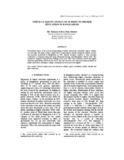| dc.contributor.author | Mamun, Md. Shamsul Arifeen Khan | |
| dc.date.accessioned | 2010-10-11T04:23:45Z | |
| dc.date.available | 2010-10-11T04:23:45Z | |
| dc.date.issued | 2008 | |
| dc.identifier.uri | http://hdl.handle.net/10361/441 | |
| dc.description.abstract | Government shares of the total recurring budget of public universities and public degree colleges are very high. The paper analyzes equity effect of government subsidy among the students of poor and non-poor household in Bangladesh in 2005. Benefit incidence analysis is done and gini coefficient is estimated using data from Household Income and Expenditure Survey 2005. The resulted is compared with previous findings of the year 1996. Gini coefficient shows that higher education opportunity still favors the reach. Over the last five years with increasing enrollment in public universities and degree colleges, inequality has been increased slightly. | en_US |
| dc.language.iso | en | en_US |
| dc.publisher | BRAC University | en_US |
| dc.relation.ispartofseries | BRAC University Journal, BRAC University;Vol.5, No.2,pp. 23-29 | |
| dc.subject | Vertical equity | en_US |
| dc.subject | Poor and non-poor students | en_US |
| dc.subject | Gross enrollment | en_US |
| dc.subject | Public subsidy | en_US |
| dc.subject | Gini-coefficient | en_US |
| dc.title | Vertical equity effect of subsidy to higher education in Bangladesh | en_US |
| dc.type | Article | en_US |

